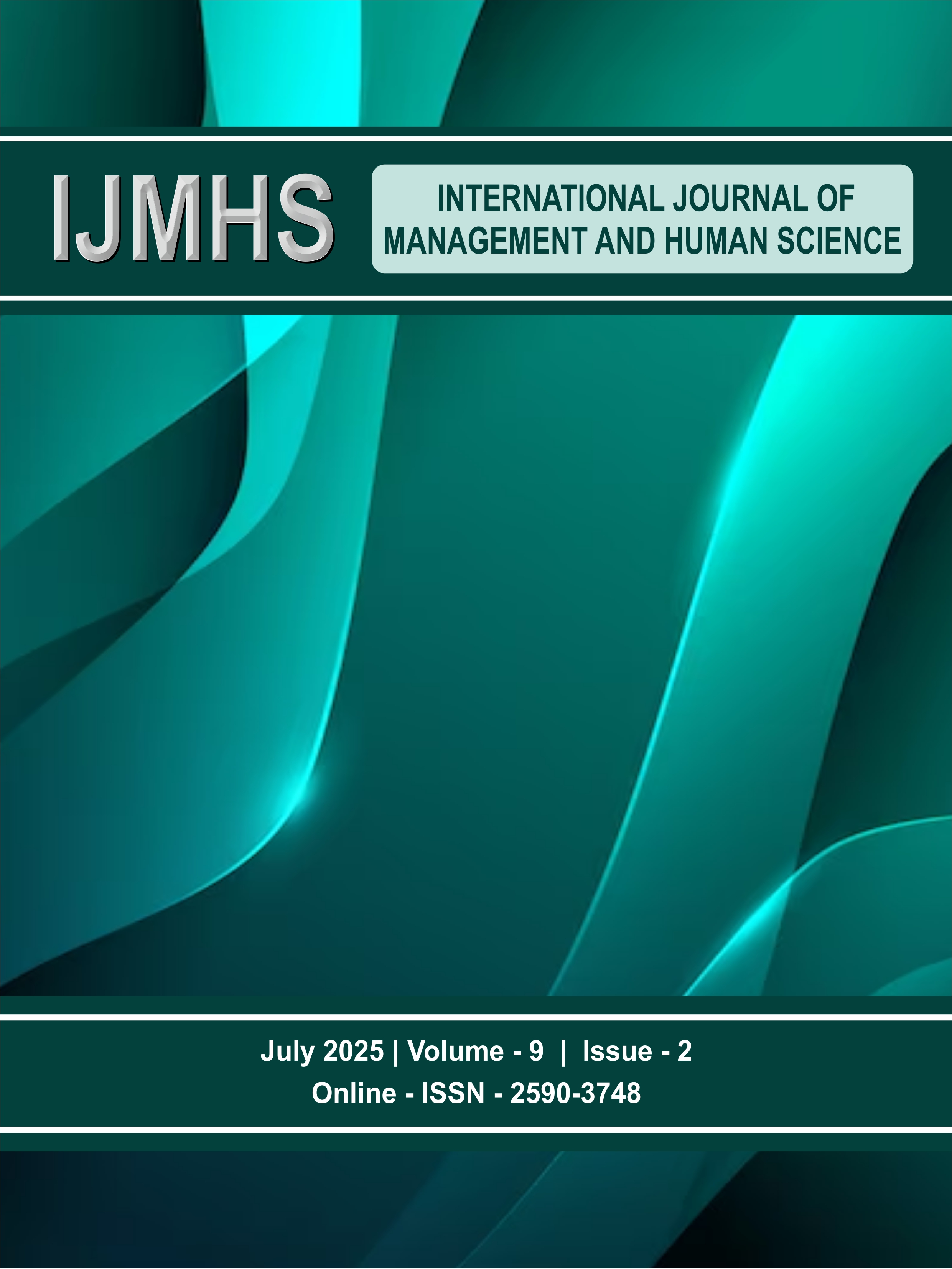Modelling the Influence of Learning Environment on Attrition Intention among Female Distance Learners in Nigeria
DOI:
https://doi.org/10.31674/ijmhs.2025.v09i02.005Abstract
Background: Female distance learners in Nigeria experience disproportionately high attrition rates compared to men. Although distance education offers flexibility, the ways in which specific aspects of the learning environment shape female students’ decisions to persist or withdraw remain underexplored. Objective: This study investigated the influence of six learning environment dimensions on attrition intention among this vulnerable population. Methods: A cross-sectional survey design was employed. Data from 433 female students across three Nigerian universities was analysed using Partial Least Squares Structural Equation Modelling (PLS-SEM). Results: Of the three dimensions, only the learning process dimension yielded a significant predictor. Specifically, student autonomy was negatively related to attrition intention (β = -0.228, p = 0.001), while active learning and all other constructs under social support and content relevance showed no significant effects. The model demonstrated modest predictive power (Q² = 0.045). Conclusion: The findings underscore the critical importance of fostering student autonomy to mitigate attrition. Empowering female learners with greater control over their learning processes is a pivotal strategy for improving retention in Nigerian distance education, potentially outweighing the influence of other environmental factors.
Keywords:
Attrition Intention, Distance Learning, Female Learner, Higher Education, Learning EnvironmentDownloads
References
Adamu, S. U., Waziri, B. K., Adesina, A., & Iro, B. (2024). The Role of Open and Distance Learning (ODL) in Promoting Access to Women's Education in Northwestern Nigeria: A Case Study of the National Open University of Nigeria (NOUN). West African Journal of Open and Flexible Learning, 12(2), 1-22. https://wajofel.org/index.php/wajofel/article/view/177/187
Adewale, S. (2024). Is virtual learning still virtually satisfactory in the post-COVID-19 era for pre-service teachers?. Educational Technology Quarterly, 2024(2), 152-165. https://doi.org/10.55056/etq.713
Adewale, S., & Tahir, M. B. (2022). Virtual learning environment factors as predictors of students' learning satisfaction during COVID-19 period in Nigeria. Asian Association of Open Universities Journal, 17(2), 120-133. https://doi.org/10.1108/AAOUJ-10-2021-0121
Akande, R. M. (2024). Institutional Support Services, Learners’ Retention, and Completion in Open-Distance Learning Institutions in South-West, Nigeria. West African Journal of Open and Flexible Learning, 13(1), 29-50. https://doi.org/10.56059/pcf10.3684
Aloia, L. S. (2021). Student learning: The influence of instructor and student confirmation, classroom connectedness, and self-efficacy. Journalism & Mass Communication Educator, 76(2), 202-215. https://doi.org/10.1177/1077695820944265
Cheng, S., Chang, H. P., & Tseng, S. S. (2024). Exploring the impact of psychosocial learning environments and instructional modalities on academic achievement in blended computer science education. European Journal of Psychology of Education, 39(4), 4493-4514. https://doi.org/10.1007/s10212-024-00884-9
Chigbundu, M. C., & Oluwabiyi, M. O. (2023). Digital Literacy, Perception and Challenges of Elearning Among Undergraduates in Public Universities of Nigeria. International Journal of Scientific Research in Multidisciplinary Studies, 9(11), 107–115.
Christo, Z., & Oyinlade, A. O. (2015). Factors of student attrition at an urban university. International Journal of Humanities and Social Science, 5(9), 9-22. https://ijhssnet.com/journals/Vol_5_No_9_1_September_2015/2.pdf
Fornell, C., & Larcker, D. F. (1981). Structural Equation Models with Unobservable Variables and Measurement Error: Algebra and Statistics. Journal of Marketing Research, 18, 382-388. https://doi.org/10.2307/3150980
Hagenkötter, R., Nachtigall, V., Rolka, K., & Rummel, N. (2024). Model authenticity in learning mathematical experimentation: how students perceive and learn from scientist and peer models. European Journal of Psychology of Education, 39(4), 3301-3324. https://doi.org/10.1007/s10212-024-00843-4
Hair Jr., J. F., Hult, G. T. M., Ringle, C. M., Sarstedt, M., Danks, N. P., & Ray, S. (2021). Evaluation of formative measurement models. In Partial least squares structural equation modeling (PLS-SEM) using R: A workbook (pp. 91-113). Cham: Springer International Publishing. https://doi.org/10.1007/978-3-030-80519-7_5
Halim, F. S. A., Buhari, T. A., Rahmat, N. H., & Seau, L. S. (2024). Investigating Student Strategy in Online Learning: The Role of Student Interaction and Engagement in Online Distance Learning among UiTM Students. International Journal of Research and Innovation in Social Science, 8(8), 4104–4118. https://dx.doi.org/10.47772/IJRISS.2024.8080310
Henseler, J., Ringle, C. M., & Sarstedt, M. (2015). A new criterion for assessing discriminant validity in variance-based structural equation modeling. Journal of the Academy of Marketing Science, 43(1), 115-135. https://doi.org/10.1007/s11747-014-0403-8
Hernández, E. H., Lozano-Jiménez, J. E., de Roba Noguera, J. M., & Moreno-Murcia, J. A. (2022). Relationships among instructor autonomy support, and university students’ learning approaches, perceived professional competence, and life satisfaction. PLoS One, 17(4), e0266039. https://doi.org/10.1371/journal.pone.0266039
Hernandez, J. S. (2012). Am I directing or micromanaging?. Physician Executive, 38(5), 70.
Joseph Lobo, G. (2017). Active learning interventions and student perceptions. Journal of Applied Research in Higher Education, 9(3), 465–473. https://doi.org/10.1108/jarhe-09-2016-0061
Kelly, M. L., Yeigh, T., & Hudson, S. (2024). Secondary teachers’ beliefs about the importance of teaching strategies that support behavioural, emotional and cognitive engagement in the classroom. Social Sciences & Humanities Open, 9, 100891. https://doi.org/10.1016/j.ssaho.2024.100891
Moore, M. G. (2013). The theory of transactional distance. In Handbook of distance education (pp. 66-85). Routledge. https://simplebooklet.com/userFiles/a/5/3/1/0/7/q5HEHV1Rez3QmmZT4GOApp/SQDx3GOV.pdf
Núñez-Regueiro, F., Verger, N. B., Bressoux, P., Batruch, A., Bouet, M., Bressan, M., ... & Pansu, P. (2025). How teacher autonomy support and student creativity jointly contribute to self-regulated learning: a dynamic, person-environment fit perspective. Thinking Skills and Creativity, 101873. https://doi.org/10.1016/j.tsc.2025.101873
Rickert, N. P., Dancis, J. S., & Skinner, E. A. (2024). Dynamics of teacher autonomy support in early adolescence: feedforward and feedback effects with students’ autonomy, competence, relatedness, and engagement. European Journal of Psychology of Education, 39(3), 2575–2601. https://doi.org/10.1007/s10212-024-00852-3
Rovai, A. P. (2002). Building sense of community at a distance. International Review of Research in Open and Distributed Learning, 3(1), 1-16. https://doi.org/10.19173/irrodl.v3i1.79
Sarstedt, M., Ringle, C. M., & Hair, J. F. (2021). Partial least squares structural equation modeling. In Handbook of market research (pp. 587-632). Cham: Springer International Publishing. https://doi.org/10.1007/978-3-319-57413-4_15
Stead, W., Manne-Goehler, J., Blackshear, L., Marcelin, J. R., Salles, A., Del Rio, C., & Krakower, D. (2023, January). Wondering if I’d get there quicker if I was a man: factors contributing to delayed academic advancement of women in infectious diseases. In Open Forum Infectious Diseases (Vol. 10, No. 1, p. ofac660). US: Oxford University Press. https://doi.org/10.1093/ofid/ofac660
Tinto, V. (1975). Dropout from higher education: A theoretical synthesis of recent research. Review of Educational Research, 45(1), 89-125. https://doi.org/https://doi.org/10.3102/00346543045001089
Van Zoonen, W., & Sivunen, A. E. (2022). The impact of remote work and mediated communication frequency on isolation and psychological distress. European Journal of Work and Organizational Psychology, 31(4), 610-621. https://doi.org/10.1080/1359432X.2021.2002299
Walker, S. L., & Fraser, B. J. (2005). Development and validation of an instrument for assessing distance education learning environments in higher education: The Distance Education Learning Environments Survey (DELES). Learning Environments Research, 8(3), 289-308. https://doi.org/10.1007/s10984-005-1568-3
World Bank. (2025). Girls' Education. World Bank Group. https://www.worldbank.org/en/topic/girlseducation
Wu, X., & Xu, C. (2025). Construction of a model of factors influencing student learning experiences in a blended collaborative learning model: A quantitative evaluation. Education and Information Technologies, 30(5), 6213-6235. https://doi.org/10.1007/s10639-024-13062-7
Yang, H., & Romero-Hall, E. (2024). A pilot study exploring interaction and student satisfaction in asynchronous courses in higher education. TechTrends, 68(4), 761-770. https://doi.org/10.1007/s11528-024-00986-7
Yila, U. M., & Azeez, B. O. (2018). Barriers to women participation in information society in Nigeria. Journal of Social Science for Policy Implications, 6(1), 10-17. https://doi.org/10.15640/jsspi.v6n1a2
Zhang, Y. (2022). Influence of teacher-student interaction on course learning effect in distance education. International Journal of Emerging Technologies in Learning, 17(10), 215-226. https://doi.org/10.3991/ijet.v17i10.30913
Published
How to Cite
Issue
Section
License
Copyright (c) 2025 International Journal of Management and Human Science (IJMHS)

This work is licensed under a Creative Commons Attribution-NonCommercial-NoDerivatives 4.0 International License.
















